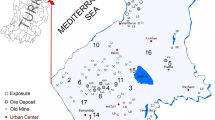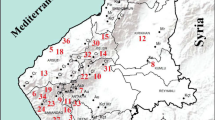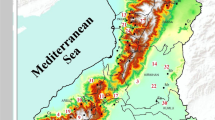Abstract
The use of plants in treatments has been as old as humanity and it has preserved its popularity for centuries til now because of their availability, affordability and safeness. However, despite their widespread use, safety and quality issues have been major concerns in the world due to industrial- and anthropogenic-based heavy metal contamination risks. Thus, this study was attempted to analyze the heavy metal levels and mineral nutrient status of widely used medicinal plants in Turkey to have insights about their health implications on humans. The plant concentrations of B, Ca, Cd, Cr, Cu, Fe, K, Mg, Mn, Na, Ni, Pb and Zn were analyzed by ICP-OES in the leaves of 44 medical plants purchased from herbal markets of three different districts of Istanbul/Turkey. The measured lowest to highest concentrations were 0.065–79.749 mg kg−1 B, 921.802–12,854.410 mg kg−1 Ca, 0.020–0.558 mg kg−1 Cd, 0.015–4.978 mg kg−1 Cr, 0.042–8.489 mg kg−1 Cu, 34.356–858.446 mg kg−1 Fe, 791.323–15,569.349 mg kg−1 K, 102.236–2837.836 mg kg−1 Mg, 4.915–91.519 mg kg−1 Mn, 10.224–3213.703 mg kg−1 Na, 0.001–5.589 mg kg−1 Ni, 0.003–3.636 mg kg−1 Pb and 2.601–36.102 mg kg−1 Zn. Those levels in plants were in acceptable limits though some elements in some plants have high limits which were not harmful. Variations (above acceptable limits) in element concentrations also indicated that these plants could be contaminated with other metals and that genetic variations may influence accumulation of these elements at different contents. Overall, analyzed medicinal plants are expected not to pose any serious threat to human health.
Similar content being viewed by others
References
Okatch H, Ngwenya B, Raletamo KM et al (2012) Determination of potentially toxic heavy metals in traditionally used medicinal plants for HIV/AIDS opportunistic infections in Ngamiland District in northern Botswana. Anal Chim Acta 730:42–48
Kumar V, Roy S, Barman D (2015) Effect of Mikania cordata (Burm) BL Robins. on non-specific immune response of Catla catla (Hamilton, 1822) against Aphanomyces invadans. Fish Technol 52:20–25
Street RA, Stirk WA, Van Staden J (2008) South African traditional medicinal plant trade—challenges in regulating quality, safety and efficacy. J Ethnopharmacol 119:705–710
Yeh ML, Lin KC, Chen HH et al (2015) Use of traditional medicine and complementary and alternative medicine in Taiwan: a multilevel analysis. Holist Nurs Pract 29:87–95
Heinrich M (2000) Ethnobotany and its role in drug development. Phytother Res 14:479–488
Saad B, Said O (2011) Greco-Arab and Islamic herbal medicine: traditional system, ethics, safety, efficacy, and regulatory issues. John Wiley & Sons
Mahmood A, Rashid S, Malik RN (2013) Determination of toxic heavy metals in indigenous medicinal plants used in Rawalpindi and Islamabad Cities, Pakistan. J Ethnopharmacol 148:158–164
Calixto JB (2005) Twenty-five years of research on medicinal plants in Latin America: a personal review. J Ethnopharmacol 100:131–134
WHO (2005) Quality control methods for medicinal plant materials. World Health Organization, Geneva
Ernst E (2002) Toxic heavy metals and undeclared drugs in Asian herbal medicines. Trends Pharmacol Sci 23:136–139
Steenkamp V, Cukrowska E, Stewart MJ (2006) Metal concentrations in South African traditional herbal remedies. Res Lett S Afr J Sci 102:256–258
Dargan PI, Gawarammana IB, Archer JRH et al (2008) Heavy metal poisoning from Ayurvedic traditional medicines: an emerging problem? Int J Environ Health 2:463–472
Chan TYK, Tomlinson B, Critchley AJH (1993) Chinese herbal medicines revisited: a Hong Kong perspective. Lancet 342:1532–1534
Caldas ED, Machado LL (2004) Cadmium, mercury and lead in medicinal herbs in Brazil. Food Chem Toxicol 42:599–603
Street RA (2012) Heavy metals in medicinal plant products—an African perspective. S Afr J Bot 82:67–74
Murch SJ, Haq K, Rupasinghe HPV et al (2003) Nickel contamination affects growth and secondary metabolite composition of St. John’s wort (Hypericum perforatum L.) Environ Exp Bot 49:251–257
Osma E, Ozyigit II, Leblebici Z et al (2012) Determination of heavy metal concentrations in tomato (Lycopersicon esculentum Miller) grown in different station types. Rom Biotechnol Lett 17:6962–6974
Van der Ent A, Baker AJ, Reeves RD et al (2013) Hyperaccumulators of metal and metalloid trace elements: facts and fiction. Plant Soil 362:319–334
Severoglu Z, Ozyigit I I, Dogan I et al (2015) The usability of Juniperus virginiana L. as a biomonitor of heavy metal pollution in Bishkek City, Kyrgyzstan. Biotechnol Biotec Eq.
Yasar U, Ozyigit II, Demir G et al (2012) Determination of hair iron levels of healthy female high school students with AAS in the Pendik District, Istanbul-Turkey. Fresenius Environ Bull 21:2644–2648
Farag S, Das R, Strosnider WH et al. (2015) Possible health effects of living in proximity to mining sites near Potosi, Bolivia
Ozcan MM, Harmankaya M, Gezgin S (2012) Mineral and heavy metal contents of the outer and inner tissues of commonly used fruits. Environ Monit Assess 184:313–320
Osma E, Serin M, Leblebici Z et al (2013) Assessment of heavy metal accumulations (Cd, Cr, Cu, Ni, Pb, and Zn) in vegetables and soils. Pol J Environ Stud 22:1449–1455
Saglam C (2013) Heavy metal accumulation in edible parts of some cultivated plants and media samples from a volcanic region in southern Turkey. Ekoloji 22:1–8
Gurel S, Basar H (2014) Metal status of olive trees grown in southeastern Marmara Region of Turkey. Commun Soil Sci Plan 45:1464–1479
Obiajunwa EI, Adebajo AC, Omobuwajo OR (2002) Essential and trace element contents of some Nigerian medicinal plants. J Radioanalytical Nuclear Chem 252:473–476
Wagesho Y, Chandravanshi B S (2010) Levels of essential and non-essential metals in ginger (Zingiber officinale) cultivated in Ethiopia. Url: http://etd.aau.edu.et//dspace/handle/123456789/2354. Retrieved
Saracoglu I A (2008) Tıbbi Bitkiler Rehberi. Pegasus Press pp 1–224
Saracoglu I A (2011) Şifa Kitabı. Hayy kitap Press pp 1–157
Eisenman S W, Struwe L, Zaurov D E (2012) Medicinal plants of Central Asia: Uzbekistan and Kyrgyzstan. Springer Science & Business Media pp 1–340
Rai M K, Cordell G A, Martinez J L, et al (2012) Medicinal plants: biodiversity and drugs. CRC Press pp1–650
Saracoglu I A (2014) Bitkisel Sağlık Rehberi, Saracoglu Press pp 1–376
Yaniv Z, Dudai N (2014) Medicinal and aromatic plants of the Middle-East (Vol. 2). Springer. pp. 1–337
TUBIVES (2015) Turkish plants data service, www.tubives.org.
Altay V, Ozyigit II, Yarci C (2010) Urban ecological characteristics and vascular wall flora on the Anatolian side of Istanbul, Turkey. Maejo Int J Sci Technol 4:483–495
Pawlisz AV (1997) Canadian water quality guidelines for Cr. Environ Toxicol Water Qual 12:123–161
Jones C, Jacobsen J (2001) Plant nutrition and soil fertility, nutrient management module no:2. Montana State University, extension service 4449-2.
Kabata-Pendias A, Pendias H (2001) Trace elements in soils. 3rd Ed. Boca Raton, London, New York, Crc Press pp. 1–413.
Corlett JL, Clegg MS, Keen CL et al (2002) Mineral content of culinary and medicinal plants cultivated by Hmong refugees living in Sacramento, California. Int J Food Sci Nutr 53:117–128
Zayed AM, Terry N (2003) Chromium in the environment: factors affecting biological remediation. Plant Soil 249:139–156
Blum W E H, Horak O, Mentler A et al (2014) Trace elements. Environmental and ecological chemistry, Sabljic a. (Éditeur). Encyclopedia of life support systems (EOLSS), developed under the auspices of the UNESCO, Oxford, UK.
Kacar B, Katkat V (2007) Bitki Besleme Nobel Yayınları pp. 1–379.
Kabata-Pendias A, Mukherjee A B, (2007) Trace elements from soil to human Berlin: Springer pp. 1–550.
Yasar U, Ozyigit II, Serin M (2010) Judas tree (Cercis siliquastrum L. subsp. siliquastrum) as a possible biomonitor for Cr, Fe and Ni in Istanbul (Turkey). Rom Biotechnol Lett 15:4979–4989
Nirupa N, Prasad M N V, (2008) Iron bioavailability, homeostasis through phytoferritins and fortification strategies: implications for human health and nutrition, in: Trace elements as contaminants and nutrients: consequences in ecosystems and human health, Ed. M.N.V. Prasad, John Wiley & Sons, Inc pp. 233–266
Wei J, Theil EC (2000) Identification and characterization of the iron regulatory element in the ferritin gene of a plant (soybean). J Biol Chem 275:17488–17493
Schmidt W (2003) Iron homeostasis in plants: sensing and signaling pathways. J Plant Nutr 26:2211–2230
Taylor DJC, Page DC, Geldenhuys P (1988) Iron and steel in South Africa. J South Afr Inst Min Metal 88:73–95
Müller DB, Wang T, Duval B et al (2006) Exploring the engine of anthropogenic iron cycles. Proc Natl Acad Sci 103:16111–16116
Akguc N, Ozyigit II, Yasar U et al (2010) Use of Pyracantha coccinea Roem. as a possible biomonitor for the selected heavy metals. Int J Environ Sci Tec 7:427–434
Mamani MCV, Aleixo LM, de Abreu MF et al (2005) Simultaneous determination of cadmium and lead in medicinal plants by anodic stripping voltammetry. J Pharmaceut Biomed 37:709–713
Ebrahim AM, Eltayeb MH, Khalid H et al (2012) Study on selected trace elements and heavy metals in some popular medicinal plants from Sudan. J Nat Med 66:671–679
Subramanian R, Gayathri S, Rathnavel C et al (2012) Analysis of mineral and heavy metals in some medicinal plants collected from local market. Asian Pacific Journal of Tropical Biomedicine 2:74–78
Ajasa AMO, Bello MO, Ibrahim AO et al (2004) Heavy trace metals and macronutrients status in herbal plants of Nigeria. Food Chem 85:67–71
Esetlili BC, Pekcan T, Çobanoglu O et al (2014) Essential plant nutrients and heavy metals concentrations of some medicinal and aromatic plants. J Agr Sci 20:239–247
Chan K (2003) Some aspects of toxic contaminants in herbal medicines. Chemosphere 52:1361–1371
Balasubramanian R, He J, Wang L K (2009) Control, management, and treatment of metal emissions from motor vehicles, In Shammas, LK; Wang, JP; Chen, Y et al. Heavy metals in the environment. CRC Press pp. 475–490
Olowoyo JO, Okedeyi OO, Mkolo NM et al (2012) Uptake and translocation of heavy metals by medicinal plants growing around a waste dump site in Pretoria, South Africa. South Afr J Bot 78:116–121
Vaculík M, Jurkovic L, Matejkovic P, et al (2013) Potential risk of arsenic and antimony accumulation by medicinal plants naturally growing on old mining sites. Water Air Soil Pollut 224
Jaison S, Muthukumar T (2017) Chromium accumulation in medicinal plants growing naturally on tannery contaminated and non-contaminated soils. Biological trace element research. Biol Trace Elem Res 175(1):223–235
Ozcan MM, Akbulut M (2008) Estimation of minerals, nitrate and nitrite contents of medicinal and aromatic plants used as spices, condiments and herbal tea. Food Chem 106:852–858
Lubbe A, Verpoorte R (2011) Cultivation of medicinal and aromatic plants for speciality industrial materials. Ind Crop Prod 34:785–801
WHO (2003) Guidelines on good agricultural and collection practices (GACP) for medicinal plants. Geneva
Acknowledgments
We would like to express our special gratitude to Dr. Mehmet Emin Uras and Dr. Recep Vatansever for their assistance from Marmara University, Department of Biology. Also, we are thankful to Assoc. Prof. Dr. Birsen Eygi Erdogan from Marmara University, Department of Statistics for the statistical analyses. This study was supported in part by the Research Foundation of Marmara University (BAPKO), Project No. FEN-C-YLP-130612-0230.
Author information
Authors and Affiliations
Corresponding author
Appendices
Appendix 1
Appendix 2
Hierarchical cluster analysis, dendrogram using average linkage (Between Species). 1- Achillea millefolium L., 2- Alchemilla alpina L., 3- Alkanna tinctoria L., 4- Artemisia absinthium L., 5- Artemisia dracunculus L., 6- Avena sativa L., 7- Berberis vulgaris L., 8- Camellia sinensis L., 9- Capsella bursa-pastoris L., 10- Cassia acutifolia Del., 11- Cinchona succirubra L., 12- Citrus aurantium L., 13- Cynara scolymus L., 14- Ficaria verna Huds., 15- Foeniculum vulgare Mill., 16- Fumaria officinalis L., 17- Galium aparine L., 18- Ginkgo biloba L., 19- Helichrysum arenarium L., 20- Humulus lupulus L., 21- Hypericum perforatum L., 22- Juglans regia L., 23- Lamium album L., 24- Laurus nobilis L., 25- Lavandula stoechas L., 26- Melissa officinalis L., 27- Morus nigra L., 28- Myrtus communis L., 29- Ocimum basilicum L., 30- Olea europaea L., 31- Origanum majorana L., 32- Persea gratissima Mill., 33- Plantago lanceolata L., 34- Rosmarinus officinalis L., 35- Rubus fruticosus L., 36- Ruta graveolens L., 37- Salvia officinalis L., 38- Sideritis condensata Boiss. et Heldr., 39- Solidago virgaurea L., 40- Sorbus domestica L., 41- Symphytum officinale L., 42- Taraxacum officinale F.H. Wigg, 43- Tussilago farfara L., 44- Viscum album L.
Rights and permissions
About this article
Cite this article
Ozyigit, I.I., Yalcin, B., Turan, S. et al. Investigation of Heavy Metal Level and Mineral Nutrient Status in Widely Used Medicinal Plants’ Leaves in Turkey: Insights into Health Implications. Biol Trace Elem Res 182, 387–406 (2018). https://doi.org/10.1007/s12011-017-1070-7
Received:
Accepted:
Published:
Issue Date:
DOI: https://doi.org/10.1007/s12011-017-1070-7




